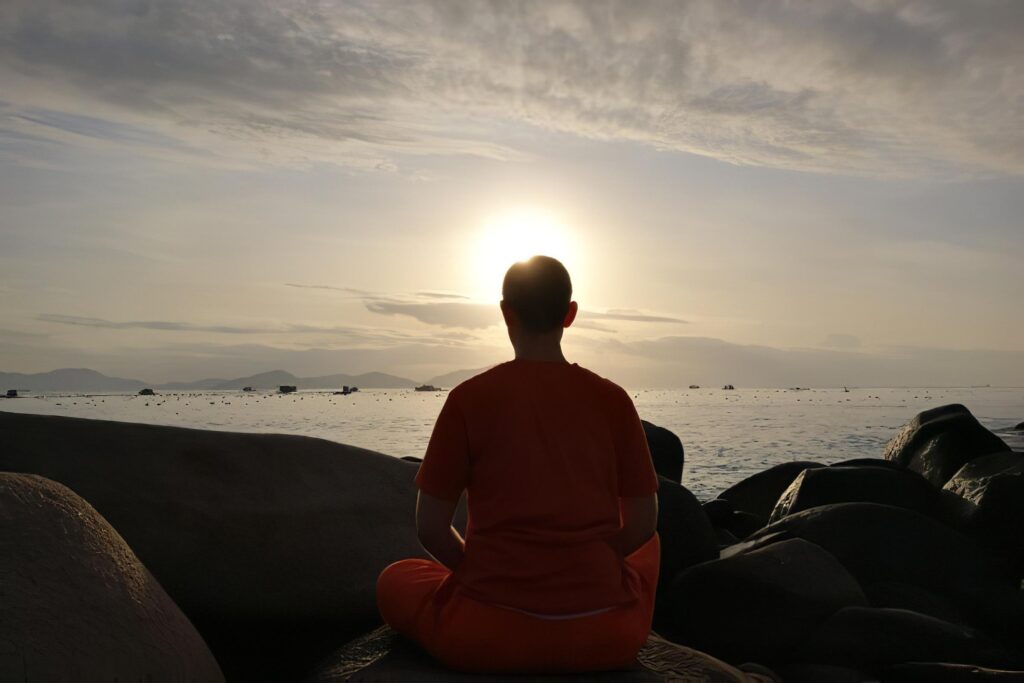When we chant the Gayatri mantra we meditate on the sun. The light of the sun permeates the three planetary systems, bhuh, bhuvah, and svah, and fills them with life. This meditation on the divine light of the sun fills us with enthusiasm. However, who is the sun? Would the sun be just the planet, composed of material elements? Would the sun we meditate upon be the demigod who presides over the cosmic body of the Sun? Would the object of meditation be actually something else?

In his Sat Sandarbhas, Srila Jiva Goswami explains that one’s understanding of the sun as he meditates on it will vary according to his level of understanding. Materialists can’t see anything spiritual, and thus they meditate on the sun as the celestial body, or as a manifestation of the material energy. The ones who are a little advanced meditate on Vivasvan, the demigod who presides over the sun, while the ones who are more advanced understand that the light of the sun is a reflection of the spiritual light of the Supreme Brahman. However, the ones who are still more advanced go beyond this impersonal conception and understand that the light of the sun is a reflection of the effulgence of the Supreme Person, and thus they meditate on that Supreme Person who is the origin of the sun.
This discussion about the person in the sun is also found in the Vedanta Sutra (1.1.20), where it is mentioned:
antas tad-dharmopadeśāt
(The person within the sun is the Supreme Person because his qualities are mentioned.)
This discussion about the person within the sun is thus not just a talk about astronomy, but a very essential discussion that essentially determines one’s conception of the divine, the object of his meditation, and ultimately the goal of his spiritual practice.
This verse of the Vedanta Sutra concludes that the person within the sun is not just matter, a demigod, or even impersonal spiritual light, but is a person, with a form and qualities. This again expands our understanding of Brahman, Who is discussed since the first verse of the Vedanta Sutra. Brahman is a person who has a spiritual form, spiritual desires, and spiritual qualities. The person within the sun is thus ultimately Paramatma.
Sri Baladeva makes this point clear in the Govinda Bhasya: “Paramātmā is the person in the eye and the sun, because the teachings describe the Lord’s qualities.”
This discussion continues on the next sutra:
bheda-vyapadeśāc cānyaḥ
(On account of the declaration of difference, there is another (different from the demigod).
To understand that the object of meditation is not the sun as a mass of material elements, but a divine personality within the sun is relatively easy to understand, but one could cling to the idea that the object of meditation is the demigod who presides over the sun, or that the demigod within the sun is not different from the Supreme Brahman.
This verse explains that this is not the case, emphasizing that the Vedas clearly explain the difference between the Supreme Person and the individual souls, including the demigod presiding over the sun.
In the highest sense, everything that exists in the material universe is conscious. When we see a person, we may think that this person is just a body composed of material elements, but someone who has a higher vision can understand that the person is not the body, but the soul within the body. Similarly, all different planets and stars, and even material influences such as anger and greed have all their predominating deities, such as demigods and other subtle beings who preside over these celestial bodies and energies. The demigod thus presides over some celestial body composed of matter, and inside the body of the demigod, there is an individual spirit soul.
However, apart from the spirit soul, situated within the heart, there is another soul, the Supersoul, or Paramatma. Therefore, when we meditate on the sun we can understand that apart from the demigod, the Supreme Person is also there in the form of Paramatma, and ultimately the light of the sun comes from this Supreme Person. The same applies to all living beings: there is the material body, the individual soul inside the heart, and Paramatma.
The difference between the individual soul and Paramatma is explained in numerous passages through the Vedas. In his commentary to this sutra, Srila Visvanatha Chakravarti Thakura quotes a verse from the Bṛhad-āraṇyaka Upaniṣad (3.7.9) which states: ya āditye tiṣṭhann ādityād antaro yam ādityo na veda yasyādityaḥ śarīraṁ ya ādityam antaro yamayaty eṣa ta ātmāntaryāmy amṛtaḥ
“He who resides in the sun, who is different from that deity, whom the deity of the sun does not know, who has the sun deity as his body, who controls the sun deity from within, is the eternal Lord within (antaryāmī).”
Sri Baladeva makes this distinction between the demigod of the sun and Paramatma clear in his commentary:
“The person mentioned is the Lord because of statements showing the difference between the jīva in the sun and the Lord in the sun.”
